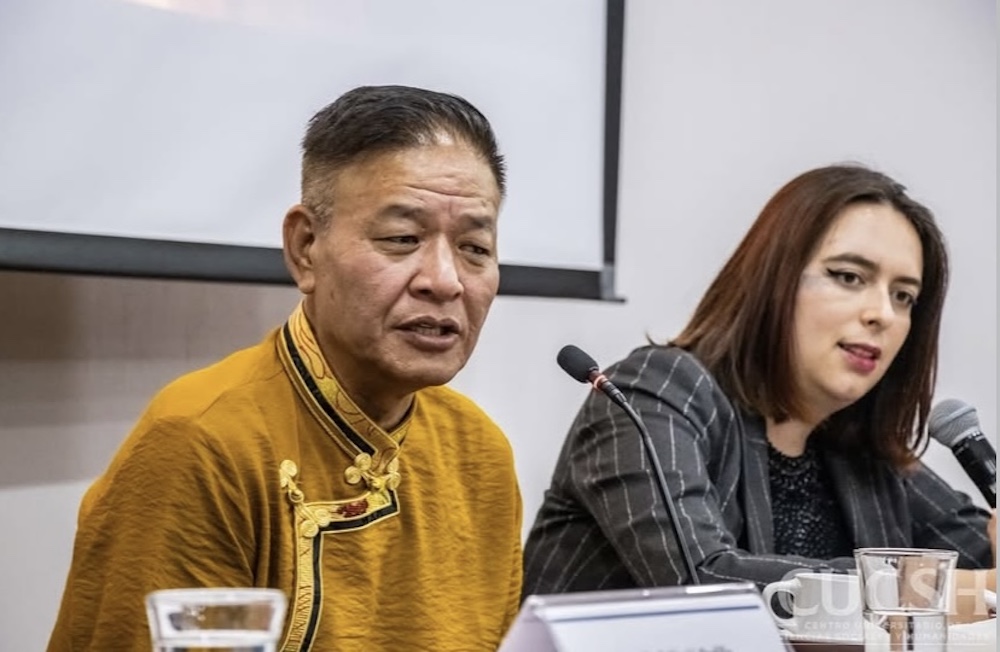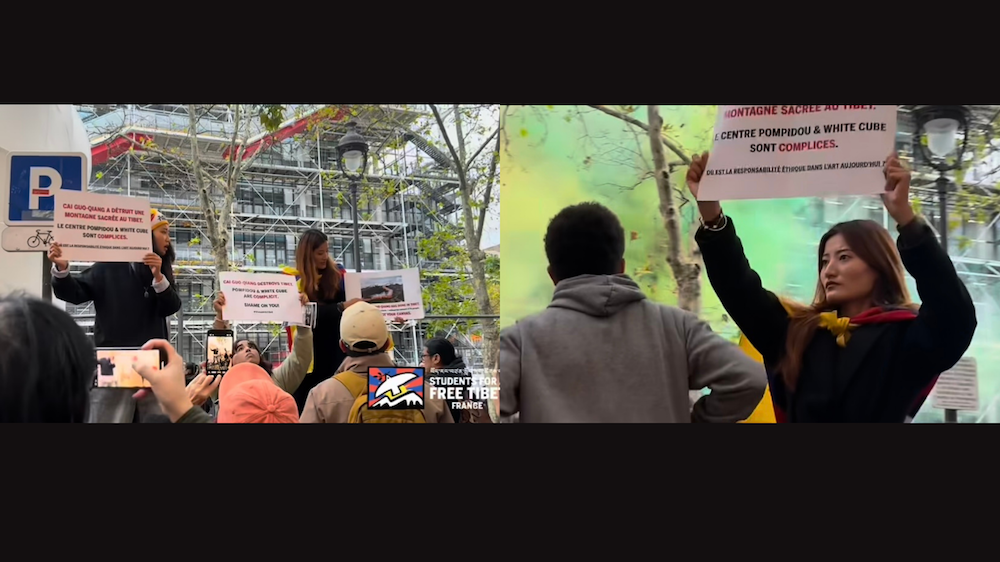By Elliot Sperling and Larry Gerstein
 Taktser Rinpoche, Thubten Jigme Norbu, passed away at the age of 86 on Friday, September 5, 2008. His life was one of devotion to the cause of Tibet. With his unwavering belief that the Tibetan majority was right, he lived to see Tibetans demonstrate once more, in the spring of 2008, that their struggle for a free and independent Tibet would not succumb to Chinese oppression. Until the day he passed away, Rinpoche’s fondness for and faith in His Holiness the Dalai Lama, his younger brother, remained as strong as his stand for Tibet’s independence.
Taktser Rinpoche, Thubten Jigme Norbu, passed away at the age of 86 on Friday, September 5, 2008. His life was one of devotion to the cause of Tibet. With his unwavering belief that the Tibetan majority was right, he lived to see Tibetans demonstrate once more, in the spring of 2008, that their struggle for a free and independent Tibet would not succumb to Chinese oppression. Until the day he passed away, Rinpoche’s fondness for and faith in His Holiness the Dalai Lama, his younger brother, remained as strong as his stand for Tibet’s independence.
Taktser Rinpoche was born in Amdo, Tibet, in 1922 and, while still a child, recognized by the 13th Dalai Lama as the 23rd incarnation of the previous Taktser Trulku. At the age of eight, he was taken to the famous monastery of Kumbum and educated there as one of its most important lamas. Kumbum monastery is the birthplace of Lama Tsongkapa who is the founder of the Gelugpa sect of Tibetan Buddhism.
When Rinpoche’s younger brother was recognized as the Dalai Lama he traveled to Lhasa, in Central Tibet, and continued his studies at the renowned monastery of Drepung. He returned to Amdo and was serving as the Abbot of Kumbum when the Chinese People’s Liberation Army arrived in 1949 and put the monastery under its control. Under the most severe of circumstances, he tried to shield his region from the inevitable oppression that was being implemented by the new Communist regime. For over a year, he was in the hands of the Chinese government and only broke free when he agreed to travel to Lhasa under their instructions, to urge His Holiness to accept Tibet’s annexation by China. Taktser Rinpoche was told that should His Holiness refuse China’s designs, he should be removed, even if it meant murder; and if that were to happen, Rinpoche was further told that he would then be made Tibet’s ruler. However, as soon as he crossed into the areas still under the control of Tibet’s legitimate government, Rinpoche escaped from his Chinese escorts and immediately reported to the then fifteen year old Dalai Lama all that had happened in Chinese-ruled Amdo, including China’s attempt to incite his death.
Taktser Rinpoche told His Holiness that there was no way for Tibet to survive under Chinese rule and urged him not to yield to Chinese force. Soon thereafter, Rinpoche left Tibet and traveled to India, where he worked to secure American support for Tibetan resistance. When His Holiness opted to accept Tibet’s incorporation into the People’s Republic of China, Rinpoche decided to remain outside Tibet and continue his work. However, his task was no longer keeping China out of Tibet: it was now freeing Tibet from China.
During the 1950s and 1960s, Rinpoche worked tirelessly for Tibet. When efforts to placate China throughout the 1950s failed and the Tibetan people rose to demand their rightful independence, Rinpoche was already poised to help. He played a pivotal role in coordinating aid for the refugees pouring into India and then in organizing and supplying Tibetan resistance fighters who continued to defy China after the Chinese army brought in massive force to crush the armed Tibetan resistance. Rinpoche also served as His Holiness The Dalai Lama’s Representative and a Tibetan Government In-Exile Representative to Japan and North America.
In 1965, Taktser Rinpoche gave up his position at the American Museum of Natural History, where he had been working for several years, to join the faculty of Indiana University’s Department of Uralic and Altaic Studies (now the Department of Central Eurasian Studies). His presence on the university’s Bloomington campus was electric: he proved to be a dynamic teacher and he imbued the department’s Tibetan Studies program with vigor and energy, helping to train several important specialists in the field. Studying with Rinpoche was a unique experience; he was a font of information and learning for his students, and was consistently generous with his knowledge and his time.
Throughout this period, and following his retirement from Indiana University in 1987, Rinpoche was a tireless fighter for the cause of Tibet. He established the Tibetan Cultural Center in Bloomington, Indiana in 1979, as a center for all things Tibetan. Its function was partly educational and Rinpoche hoped to be able to make Tibet’s situation and the nature of China’s rule over Tibet better understood. He had little time for the arguments of those who felt that Tibet would do well as an “autonomous” entity in China. He knew full well that cultural freedom and political freedom were inseparable; that political freedom meant that Tibetans must be fully free to decide their country’s fate; and that the vast majority of Tibetans wanted Tibet to be an independent country, an equal partner to other countries and a full member of the United Nations. His view of those who wanted to keep Tibet in China was well known. Thus, following his retirement he became a founder, in 1995, of the International Tibet Independence Movement and participated in many of its activities. For instance, in 1996, Rinpoche along with the Venerable Palden Gyatso led a 300-mile, 45-day March for Tibet’s Independence from China’s Embassy in Washington, D.C. to the United Nations in New York City. Further, in 1997, Rinpoche led a three-month 600+ mile March for Tibet’s Independence from China’s Embassy in Toronto to China’s Consulate in New York City. In the late 1990’s, Rinpoche also help found the Rangzen Alliance; another organization devoted to securing Tibet’s independence.
In 2004, the Tibetan Youth Congress awarded Rinpoche with its highest honor when they bestowed on him the Rangzen Award.
Rinpoche’s last official political act on behalf of Tibet occurred on June 4, 2008. At this time, he received the Tibetan Freedom Torch from his sons, Lhundrup, Kunga, and Jigme who had carried the torch by either bicycle or foot from Indianapolis to Bloomington, Indiana as part of the worldwide Tibet movement effort connected to the 2008 Beijing Olympics.
Taktser Rinpoche was a teacher, a scholar, a fighter and an activist. He was a friend to many, an implacable enemy of oppression, and a forceful yet compassionate proponent of justice. Through his books and actions he influenced innumerable people, providing them with a glimpse of Tibet’s rich civilization and Tibet’s resilient spirit. His passing is mourned by his family, his friends, students, colleagues, and by all friends of Tibet.









